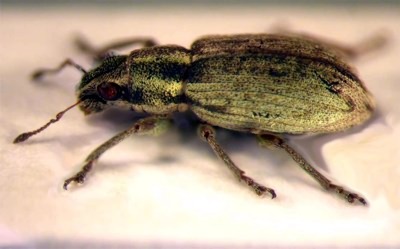Pests
Sitona humeralis Steph. - Sitona Weevil
Systematic position.
Class Insecta, order Coleoptera, family Curculionidae, genus Sitona Germar. Closely related to S. inops Gyll., differing from the latter in the absence of eyelashes on the upper eye margin. From S. cylindricollis Fahr. it differs greatly in depressed rostral dorsum and in rounded lateral sides of pronotum.Biological group.
Pest of alfalfa.Morphology and biology.
Body length, 3.4-5.1 mm. Frons and rostral dorsum deeply longitudinally depressed, frons besides with thin and deep sulcus along midline. Eyes large, convex, subrounded, distinctly protruding beyond head contour, with 3-5 eyelashes on upper margin. Pronotum weakly transverse, its lateral sides more or less rounded. Transversal sulcus on precoxal part of prosternum situated in the middle between fore coxae and apical margin of prosternum. Elytra with strong humeral angles, somewhat widened from the base toward preapical third. Elytral pubescence on the upper sides is dense, subcontinuous, consisting of broadly oval scales and subrecumbent pointed hairs, arranged in 2-3 irregular rows on the intervals. Scales are light-grayish, yellowish, or brown, with weak shine. Disc of pronotum covered with 3 longitudional light bands. Scutellum and basal part of 5-6th elytral intervals with light whitish vestiture; middle part of elytra in basal half usually darker. Adult hibernates. Oviposition begins mainly in spring, after additional feedings. Egg is suboval, 0.41 mm in diameter. Embryogenesis lasts 10-14 days. Larva has 4 instars. In the first instar it goes deep into the soil and penetrates inside root tubercles. Later larva devours thin roots, too. From S. cylindricollis the larva differs in the shape of head, which is distinctly widened toward occiput. Pupation occurs in May, pupa develops 10-14 days. Young beetles appear concurrently with extinction of adults of previous generation.Distribution.
Europe, Northern Africa, Asia Minor, Mongolia, China, introduced to the Northern America. The species inhabits the European part of the former USSR northward to Leningrad Region, whole Caucasus, the south of Western Siberia, Middle Asia, and Kazakhstan.Ecology.
Monovoltine. Moderately xerophilous. Medicago sativa and M. falcata are the main host plants of the pest. It rarely feeds on sweet clover and clover. Adults hibernate on the surface layer of soil between leafstalks at base of host plants. During winter warming, the adults are active, feed and copulate. The pest often occurs in alfalfa together with S. cylindricollis.Economic significance.
Both adults and larvae cause damage. They mainly harm alfalfa in the first year of vegetation and after cutting. Elimination of root tubercles by larvae decreases the harvest of alfalfa and nitrogen accumulation rate in plants and soil. Control measures include using fertilizations for seedling development acceleration; alfalfa growing in crop rotation less than 3 consecutive years; sowing alfalfa at a distance no less than 500 m from the old fields. Pesticide treatment is necessary in spring with high abundance of weevils.Reference citations:
Alimdzhanov, R.A. 1951. The pea weevils of the Genus Sitona Germ. from the fauna of Uzbekistan. Tashkent: AN Uzbek.SSR. 183 p. (in Russian).Baitenov, M.S. 1975. The pea weevils of the Genus Sitona Germ. from the fauna of Kazakhstan. Vestnik sel.skokhozyaistvennoi nauki Kazakhstana (2). Kurmanov, G.Sh., ed. Alma-Ata: Minsel.khoz. Kazakh.SSR. P. 121-124 (in Russian).
Ioannisiani, T.G. 1972. The weevils (Coleoptera, Curculionidae) of Byelorussia. Minsk: Nauka i Tekhnika, 352 p. (in Russian).
Isaev, A.Yu. 1994. Ecological and faunistic review of the weevils (Coleoptera: Apionidae, Rhynchophoridae, Curculionidae) of the Ulyanovsk region. Ulyanovsk: Branch of the Moscow University, 77 p. (in Russian).
Korotyaev, B.A. 1983. Family Curculionidae. In : Kopaneva, L.M., ed. Keys to harmful and useful insects and ticks on the annual and perennial grasses and leguminous plants in the USSR. Leningrad: Kolos. P. 115-127 (in Russian).
Petrukha, O.I. 1969. The pea weevils of the Genus Sitona Germ. from the fauna of USSR, damaging bean crops. Leningrad: Nauka. 255 p. (in Russian).


